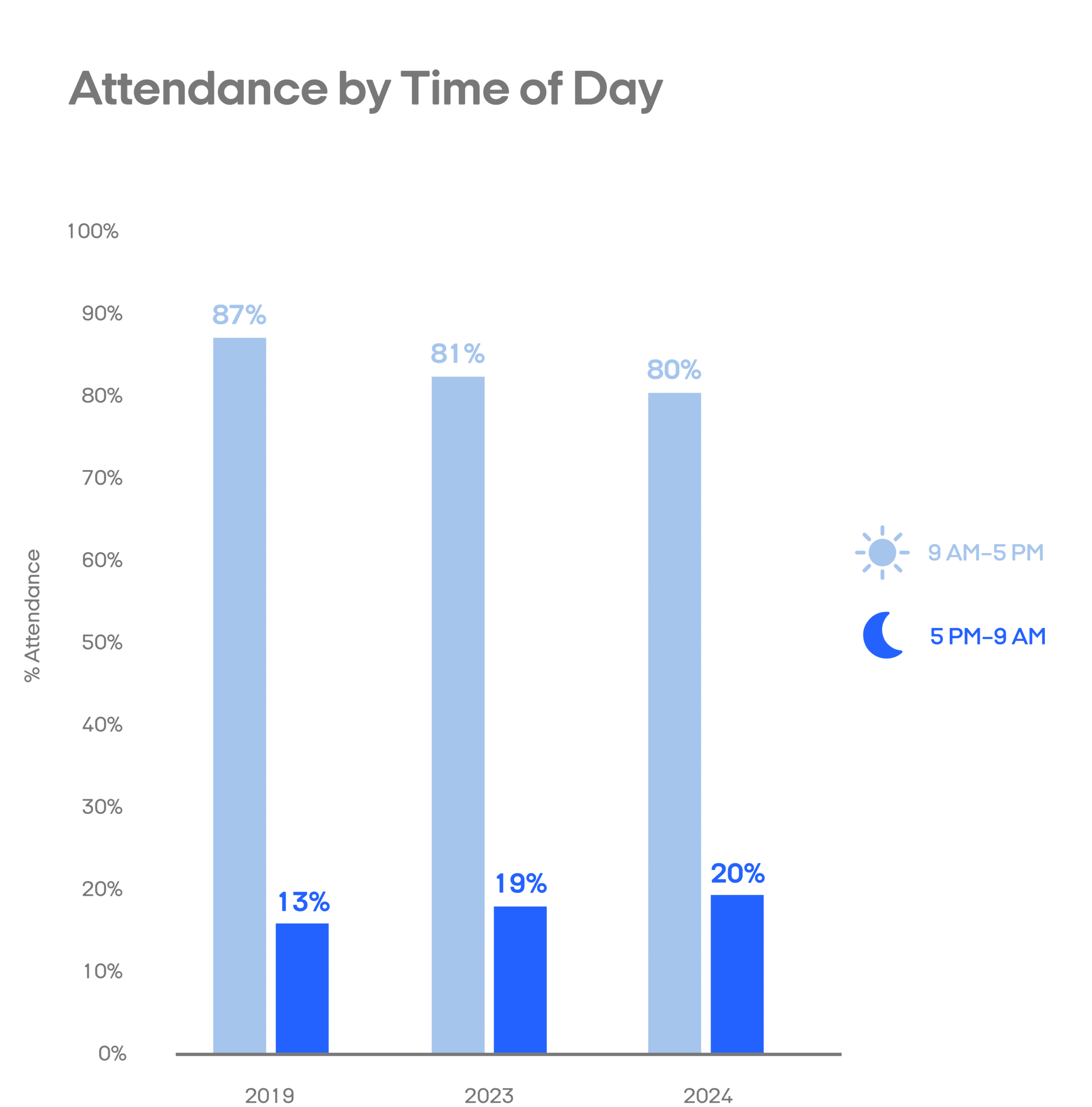September 4, 2024. What have the return-to-office trends looked like this year?
A few months into the pandemic, people began seriously questioning whether remote work would last forever. Some proclaimed that people would never go back to offices, citing employee preferences and productivity increases based on remote work in 2020. Remote work also brought tangible benefits to employers, such as the ability to recruit talent nationally or even globally, not to mention cost savings on office space.
Others observed that while individual jobs could be performed well remotely, companies as a whole were becoming less dynamic and more siloed. Employees were feeling disconnected from their peers, leading to a decline in collaboration and a reduction in institutional knowledge which would negatively impact performance. Although fully remote work policies brought tangible benefits to employees and to companies, they also brought new problems (and new vocabulary) like “Zoom fatigue,” “job stacking,” and “quiet quitting.”
Already, in 2020, many companies suggested hybrid work as part of the Goldilocks scenario. Companies could balance the efficiency and employee satisfaction that come from working from home sometimes, with the better communication, collaboration, and knowledge sharing that come from working in person. While some companies continued to espouse fully remote work or 5 days a week in person, the majority of companies looked to hybrid work as the answer. Debates raged between employers and employees and between pundits over what hybrid work would look like and whether it would succeed or fail.
Since 2015, Bevi has been building a database of workplace attendance by region and by industry. This gives us a unique view of office life throughout the pandemic and its aftermath. While the RTO debate raged over the past four years, the actual level of workplace attendance has gradually – but consistently and unmistakably – risen. In 2023 we had assumed we were finally near an equilibrium in hybrid work, with people coming to the office ~2.7 days per week, but in fact, we’ve seen workplace attendance increase even more in 2024, to an average of over 3.0 days per week (and still climbing).
Although hybrid work has taken root, in 2024 it is gradually resembling more and more of a 5-day work week, with attendance increasing on Mondays and Fridays relative to 2023 (though still comparatively light on those days relative to 2019). That said, the traditional 9-5 workday does appear to have gone away; although on average employees commute fewer days per week, our data shows that when they do go into the office, they work longer and fewer standard hours.
I’m excited to see how hybrid work continues to evolve, but one thing is clear from the data: most companies see significant value in spending time together in person.
Bevi Co-founder, Sean Grundy
Findings in this report:
- Return to office trends may exceed 2023 predictions
- We’re seeing more in-person attendance for all industries—except one
- Los Angeles and Boston are leading the return to the office
- Tuesday is still the busiest day in the office after the pandemic
- The shift away from 9-to-5 workdays continues
- What’s Powering AI? More Consistent Time in the Office Than Other Tech Companies
1. Return to office trends may exceed 2023 predictions

Ahead of previous predictions. At the start of 2024, Bevi predicted that office attendance would reach 64% of its pre-pandemic level by the end of this year. Data shows we are nearing that prediction, currently trending at 62% of average 2019 in-office attendance, as of July 2024.
What’s next? Office attendance will continue to bounce back this year, outpacing our previous expectations given dispense data trends from our internet-connected water coolers. While we initially forecasted 9% growth in office attendance from last year to this year, we now anticipate surpassing that by 5 percentage points, reaching 69% of pre-pandemic attendance by the end of 2024.
Behind the numbers. Our projection came from looking closely at aggregate usage data from our Smart Water Coolers®, which are found in thousands of offices across all 50 states. We estimate office attendance by tracking water consumption, which tends to mirror time spent by employees in the office. By aligning each month’s data with the corresponding month in 2019, we account for drinking habits in a consistent, seasonal way. This method allows us to accurately gauge shifts in office attendance since the pandemic, focusing on overall trends while ensuring individual company data remains confidential.
2. We’re seeing more in-person attendance for all industries—except one

Slow but steady. Out of the five industries we tracked, four saw increases in office attendance this year compared to last. Some industries experienced significant gains, with the technology sector showing an 11 percentage point spike in return to office trends.
Of note: now, all major industries are at more than half of 2019 pre-pandemic attendance levels.
One, and only one sector—arts, entertainment, and recreation—saw no difference in office attendance between this year and last, indicating that they may have found a new equilibrium with attendance three days per week.
Importantly, no industry is seeing less in-person attendance in 2024 than they saw in 2023—and almost all of them are seeing significantly more.
3. Los Angeles and Boston are leading the return to the office

I’m goin’ through changes. Los Angeles is seeing a rise in office attendance for multiple reasons, including California’s new hybrid work policy for state employees, which requires over 240,000 workers across the Golden State to now be in the office at least two days a week. (It’s a push that should help to bolster local economies, but not everyone is happy about it.) This jump continues a return to office trend from October of 2020 when Los Angeles employees began to trickle back into the office even as remote work dominated.
Busy in Beantown. Boston continues to outpace New York City, San Francisco, and Chicago in office attendance. This trend is supported by other foot traffic data and highlights Boston’s success in integrating in-person collaboration with effective hybrid work strategies, according to the Boston Business Journal.
Boston stands out in adapting to the future of work due to its many mixed-use developments, which have been a key focus of the city’s urban planning for over a decade. Neighborhoods such as Back Bay, Seaport, Charlestown, and South Boston blend residential, dining, and retail spaces, creating the opportunity for work-life balance close to where people actually work.
4. Tuesday is still the busiest day in the office after the pandemic

Same coordinates but a different place. We’re getting closer to pre-pandemic office attendance levels, but the workweek definitely looks different for almost everyone. While attendance is increasing on Mondays and Fridays, the middle stretch of Tuesday, Wednesday, and Thursday is still the most popular time for employees to be in the office.
Companies are still experimenting with mandates as a way to better balance how full the office is over the course of the week. Deutsche Bank, for example, now requires employees to be in the office on Fridays and Mondays as part of their time in-office.
While Mondays are making a comeback, Fridays still pose a challenge for getting people back to their desks. In early 2024, Friday attendance saw the smallest increase compared to last year. For many, Fridays have now been solidified as a relaxed, low-key day—a chance to ease into the weekend by working at their own pace, often from the comfort of their own home. That’s a return to office trend that’s not going away any time soon.
5. The shift away from 9-to-5 workdays continues

Traditional workdays are yesterday’s vibe. Although overall office attendance has increased since 2023, our adherence to the traditional 9-to-5 schedule has continued to decline. In 2024, 20% of office attendance occurs outside of these standard hours, compared to just 13% pre-pandemic.
This change marks the start of a shift away from the rigid 9-to-5 work schedule. As employees adapt to hybrid work—and gradually return to the office more frequently—the timing of when people actually show up will be different from pre-pandemic times.
With hybrid work, there’s more flexibility to manage everyday life, whether it’s avoiding rush hour, handling family duties, running errands, or making use of the office during quieter evening hours.
For many employees, this will mean showing up to the office later. Over half of adults naturally go to bed after midnight, so a standard workday was something always out of sync with many people’s internal clocks. Now, they can work when they’re most focused and inspired, leading to better quality work and less burnout. That’s a win-win return to office trend for employers and their employees, and a key reason to believe the amount of work happening outside of traditional hours will go up another two or three percentage points in 2025.
6. What’s Powering AI? More Consistent Time in the Office Than Other Tech Companies

Office attendance at AI companies generally follows similar patterns to other tech firms, but AI workers show a more balanced presence throughout the week, with higher attendance on Mondays and Fridays.
Apparently, the most innovative, fastest paced, and highest-tech industry still values old-fashioned in-person work. AI still needs humans!






